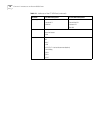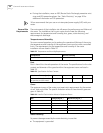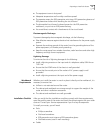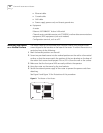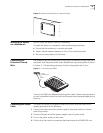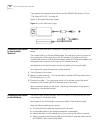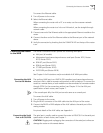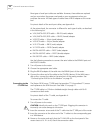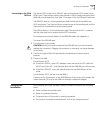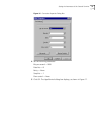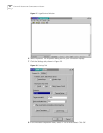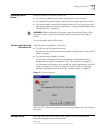
26 CHAPTER 2: INSTALLING THE ROUTER
Nine types of serial port cables are available. However, these cables are optional
and you must select the proper one based on your requirements when you
purchase the router. All these types of cables have a DB-50 adapter at the router
end.
For pinout details of the serial port cables, see Appendix A.
At the network end, the connector is different for each type of cable, as described
in the following list:
■ V.24 (EIA/TIA-232) DTE cable — DB-25 (male) adapter
■ V.24 (EIA/TIA-232) DCE cable — DB-25 (female) adapter
■ V.35 DTE cable — 34-pin (male) adapter
■ V.35 DCE cable — 34-pin (female) adapter
■ X.21 DTE cable — DB15 (male) adapter
■ X.21 DCE cable — DB15 (female) adapter
■ EIA/TIA-449 DTE cable — DB37 (male) adapter
■ EIA/TIA-449 DCE cable — DB37 (female) adapter
■ EIA-530 DTE cable — DB25 (male) adapter
Use the following procedure to connect the serial cable to the SERIAL0 port and
the DSU/CSU device:
1 Turn off power to the router.
2 Choose the appropriate serial cable.
3 Plug the DB-50 adapter of the cable into the SERIAL0 port of the router.
4 Connect the other end of the cable to the CSU/DSU device. (If the WAN uses a
dial-up line, connect the cable to the serial port of the analog modem. See
“Connecting the AUX Port to the Modem” on page 25.
Connecting to the
CT1/PRI Port
The Router 3016 hass a CT1/PRI port that provides CT1 (channelized T1) access
and implements the ISDN function. See
Table 21 on page 17.
The CT1/PRI cable is a 100-ohm shielded straight-through cable with RJ-45
connectors at both ends.
For pinout details of the T1 cable, see Appendix A.
To connect the T1 cable:
1 Turn off power to the router.
CAUTION: Identify the mark on the CT1/PRI port. Plugging the connector in
incorrectly can cause damage to the router.
2 Insert the connector at one end of the T1 cable into the CT1/PRI port of the router.
3 Insert the connector at the other end of the T1 cable into the corresponding port
in a WAN device.
4 Power on the router and verify that the T1-LNK LED on the front panel of the
router chassis is lit. If it is off, check the connection cable.



